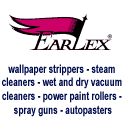 |
|||

"Tool of the Month"
Painting - Surface PreparationCoating integrity and
service life will be reduced because of improperly prepared surfaces.
Up to 80% of all coatings failures can be directly attributed to
inadequate surface preparation that affects coating adhesion. Selection
and implementation of proper surface preparation ensures coating
adhesion to the substrate and prolongs the service life of the coating
system. Selection of the proper
method of surface preparation depends on: No exterior painting should be done immediately after a rain, during foggy weather, when rain is predicted, or when the temperature is below 10°C (50°F). PREVIOUSLY
PAINTED SURFACES: Surfaces that have not been previously painted or that are exposed down to the original surface should be handled as follows: WOOD,
WOOD COMPOSITION BOARD, OR HARDBOARD:
CONCRETE
BLOCK: POURED
CONCRETE, STUCCO/MASONRY, AND CEMENT COMPOSITION BOARD: CONCRETE
FLOORS: METAL:
Brick
All brick should be allowed to weather for at least one year followed by wire brushing to remove efflorescence. Treat the bare brick with one coat of a masonry conditioner. We are constantly adding to and improving our inventory of projects, materials and tips. Please feel free to e-mail us with any information that you would like us to consider adding.
|
Get advice about...


